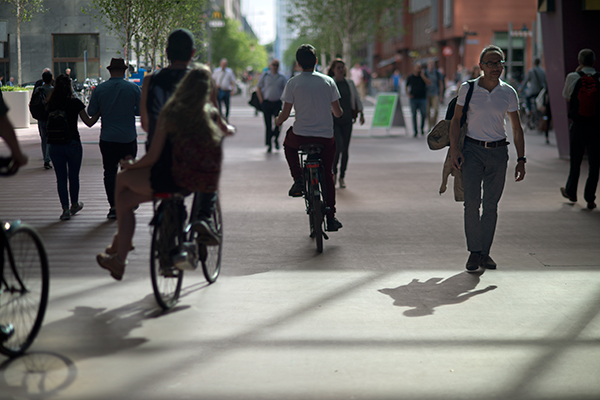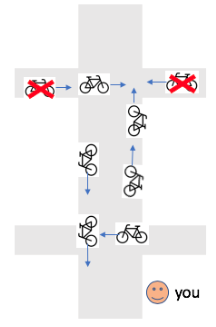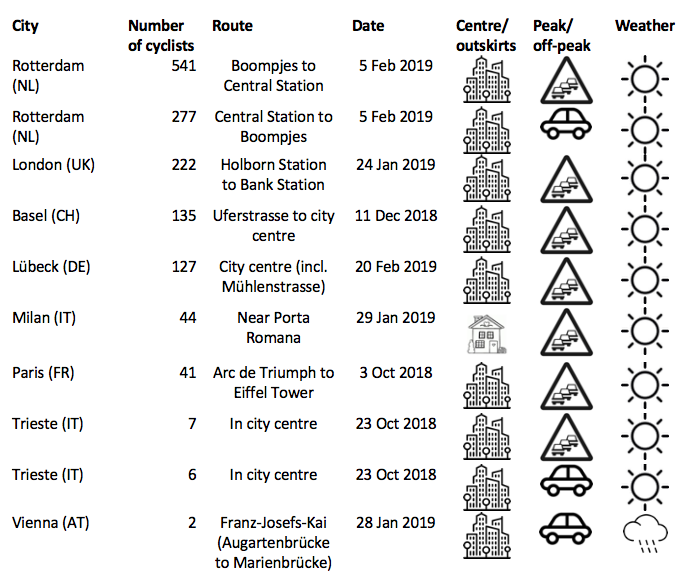City Cycling in Numbers: An intuitive indicator for cycling in cities
We’re often bombarded with facts and figures about cycling rates and mode shares in cities across the world, but how that translates to our experience moving through the city can vary significantly. Mobycon Senior Consultant, Roland Jorna, discusses how his travels have helped him to create a method for observing and comparing these experiences, and asks for your help to discover: how many people cycle in your city?

When travelling across Europe and visiting cities during my business trips, I am amazed with the differences in cycling levels in these cities. Especially compared to my experiences in The Netherlands, where the high number of cyclists makes counting them virtually impossible. Of course, one can check the share of cycling in different cities using all kinds of professional/academic publications, but if the share of cycling is 10%, irrespective of the definition used, what do we actually notice from this in the streets? Should I expect to see one cyclist for every nine cars driving around? Or should I also take into account the people in the tram and metro? For me, the ‘share of cycling’ therefore remains rather abstract. Similarly, you can ask about the definition: if one cycles to work, but drops one’s child at school, should this count for one trip or two? This can make a big difference for the resulting share of cycling. And it is said that in the Netherlands most cities have ‘countless’ number of cyclists. Is that true? And what about other cities in Europe?
I started the very intuitive ‘Mobycon City Cycling In Numbers’ to answer these questions: I walk from A to B in a city and count all cyclists that pass me (coming from behind), plus all cyclists coming towards me, plus all cyclists crossing the intersections in front of me. This total, I call the Mobycon City Cycling in Numbers (MCCIN). Its method is visualized in the figure below.

So far, I have collected the MCCIN in eight cities with very different results, as shown in the table below.

Note: not included in the number of cyclists: mopeds, parked bicycles, cyclists in side streets
So, what does this tell us? It shows that on a sunny day almost 13 times more cyclists can be seen in the city centre of Rotterdam (NL) than in Paris (FR) and 75 times more than in Trieste (IT). It also shows that in Rotterdam during peak hours twice as many cyclists can be seen as during off-peak hours. In Trieste the difference was much less, only going down from 7 to 6 cyclists. In London you can spot a cyclist on average every 8 seconds, whereas in Paris it takes 44 seconds on average before you can spot the next cyclist.
Of course this MCCIN depends on a number of factors, like the route you walk, time of day, period of the year, the weather, etc. On the other hand, it gives you a very intuitive feeling of the amount of cycling in a city. I also noticed that it gives a very nice topic for discussion during the many project dinners I have across Europe. People state their expectations for the MCCIN in their own city (Oldenburg more than 1000 per half-hour!), they wonder if it is really possible to count the cyclists in Dutch cities, and people start sending me articles about cycling (even though some of them are very car-minded).
I’m curious to see what is going on in other cities in the world. However, since I can only visit a limited number of cities per year, your help is most welcome. Use half an hour of your time and count the cyclists using the method described above, and send your results to r.jorna@mobycon.nl. I will then add the results to the MCCIN overview!

Ronald Jorna
‘ICT makes the transport chain more intelligent, which contributes to more efficient and sustainable transportation. As a staunch advocate for smart travel, I investigate how ICT can increase the safety and comfort of cyclists. European cooperation and knowledge sharing are important to this work. The choice for a certain modality is a trade-off between time, cost, quality of life and health.’
Senior Advisor ICT and Freight Specialist
r.jorna@mobycon.com

